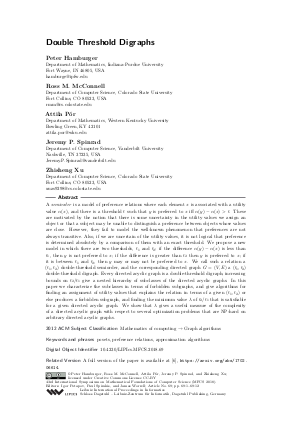Double Threshold Digraphs
Authors Peter Hamburger, Ross M. McConnell, Attila Pór, Jeremy P. Spinrad, Zhisheng Xu
-
Part of:
Volume:
43rd International Symposium on Mathematical Foundations of Computer Science (MFCS 2018)
Part of: Series: Leibniz International Proceedings in Informatics (LIPIcs)
Part of: Conference: Mathematical Foundations of Computer Science (MFCS) - License:
 Creative Commons Attribution 3.0 Unported license
Creative Commons Attribution 3.0 Unported license
- Publication Date: 2018-08-27
File

PDF
LIPIcs.MFCS.2018.69.pdf
- Filesize: 459 kB
- 12 pages
Document Identifiers
Related Versions
Subject Classification
ACM Subject Classification
- Mathematics of computing → Graph algorithms
Keywords
- posets
- preference relations
- approximation algorithms
Metrics
- Access Statistics
-
Total Accesses (updated on a weekly basis)
0Document
0Metadata
Abstract
A semiorder is a model of preference relations where each element x is associated with a utility value alpha(x), and there is a threshold t such that y is preferred to x iff alpha(y) - alpha(x) > t. These are motivated by the notion that there is some uncertainty in the utility values we assign an object or that a subject may be unable to distinguish a preference between objects whose values are close. However, they fail to model the well-known phenomenon that preferences are not always transitive. Also, if we are uncertain of the utility values, it is not logical that preference is determined absolutely by a comparison of them with an exact threshold. We propose a new model in which there are two thresholds, t_1 and t_2; if the difference alpha(y) - alpha(x) is less than t_1, then y is not preferred to x; if the difference is greater than t_2 then y is preferred to x; if it is between t_1 and t_2, then y may or may not be preferred to x. We call such a relation a (t_1,t_2) double-threshold semiorder, and the corresponding directed graph G = (V,E) a (t_1,t_2) double-threshold digraph. Every directed acyclic graph is a double-threshold digraph; increasing bounds on t_2/t_1 give a nested hierarchy of subclasses of the directed acyclic graphs. In this paper we characterize the subclasses in terms of forbidden subgraphs, and give algorithms for finding an assignment of utility values that explains the relation in terms of a given (t_1,t_2) or else produces a forbidden subgraph, and finding the minimum value lambda of t_2/t_1 that is satisfiable for a given directed acyclic graph. We show that lambda gives a useful measure of the complexity of a directed acyclic graph with respect to several optimization problems that are NP-hard on arbitrary directed acyclic graphs.
Cite As Get BibTex
Peter Hamburger, Ross M. McConnell, Attila Pór, Jeremy P. Spinrad, and Zhisheng Xu. Double Threshold Digraphs. In 43rd International Symposium on Mathematical Foundations of Computer Science (MFCS 2018). Leibniz International Proceedings in Informatics (LIPIcs), Volume 117, pp. 69:1-69:12, Schloss Dagstuhl – Leibniz-Zentrum für Informatik (2018)
https://doi.org/10.4230/LIPIcs.MFCS.2018.69
BibTex
@InProceedings{hamburger_et_al:LIPIcs.MFCS.2018.69,
author = {Hamburger, Peter and McConnell, Ross M. and P\'{o}r, Attila and Spinrad, Jeremy P. and Xu, Zhisheng},
title = {{Double Threshold Digraphs}},
booktitle = {43rd International Symposium on Mathematical Foundations of Computer Science (MFCS 2018)},
pages = {69:1--69:12},
series = {Leibniz International Proceedings in Informatics (LIPIcs)},
ISBN = {978-3-95977-086-6},
ISSN = {1868-8969},
year = {2018},
volume = {117},
editor = {Potapov, Igor and Spirakis, Paul and Worrell, James},
publisher = {Schloss Dagstuhl -- Leibniz-Zentrum f{\"u}r Informatik},
address = {Dagstuhl, Germany},
URL = {https://drops.dagstuhl.de/entities/document/10.4230/LIPIcs.MFCS.2018.69},
URN = {urn:nbn:de:0030-drops-96519},
doi = {10.4230/LIPIcs.MFCS.2018.69},
annote = {Keywords: posets, preference relations, approximation algorithms}
}
Author Details
- Department of Computer Science, Colorado State University, Fort Collins, CO 80523, USA
References
-
Thomas H. Cormen, Charles E. Leiserson, Ronald L. Rivest, and Clifford Stein. Introduction to Algorithms. MIT, 2009.

-
Peter C. Fishburn. Interval Orders and Interval Graphs: Study of Partially Ordered Sets. Wiley, 1985.

-
Peter C. Fishburn. Nontransitive preferences in decision theory. Journal of Risk and Uncertainty, 4:113-134, 1991.

-
Fanica Gavril. Maximum weight independent sets and cliques in intersection graphs of filaments. Information Processing Letters, 11:181-188, 2000.

-
John G. Gimbel and Ann N. Trenk. On the weakness of an ordered set. SIAM J. Discrete Math, 11:655-663, 1998.

- Peter Hamburger, Ross M. McConnell, Attila Pór, and Jeremy P. Spinrad. Double threshold digraphs, 2018. URL: http://arxiv.org/abs/arXiv:1702.06614.
-
Johan Hastad. Clique is hard to approximate within n^1-ε. Acta Math., 182:105-142, 1999.

-
Richard Karp. A characterization of the minimum cycle mean in a digraph. Discrete Mathematics, 23:309-311, 1978.

-
Jan Kratochvil and Jaroslav Nešetřil. Independent set and clique problems in intersection-defined classes of graphs. Comment.Math.Univ.Carolinae, 31:85-93, 1990.

-
Duncan R. Luce. Semiorders and a theory of utility discrimination. Econometrica, 24:178-191, 1956.

-
Marc Pirlot and Ph Vincke. Semiorders: Properties, Representations, Applications, volume 36 of Theory and Decision Library. Series B: Mathematical and Statistical Methods. Kluwer, 1997.

-
Jeremy P. Spinrad. Efficient Graph Representations, volume 19 of Fields Institute Monographs. American Mathematical Society, 1991.

